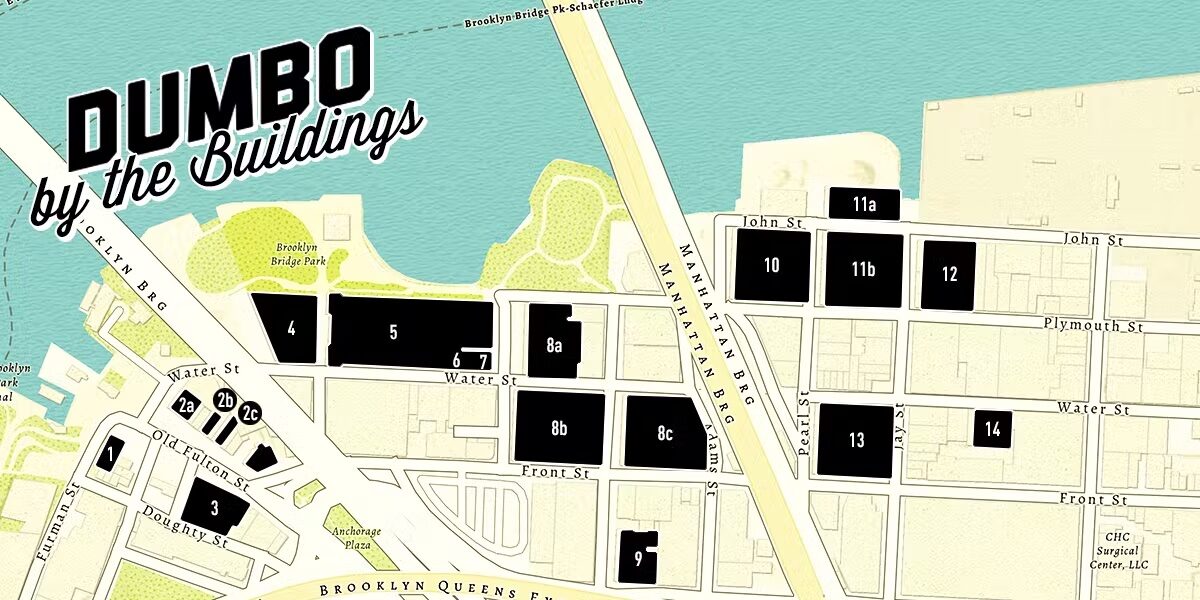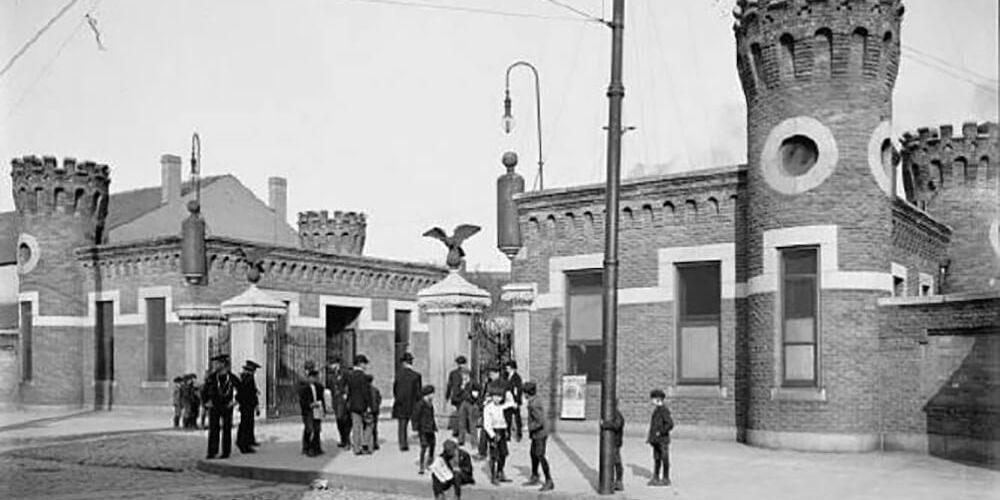
DOWN UNDER THE MANHATTAN BRIDGE OVERPASS
That’s what DUMBO stands for.
In 1978, residents living between the Brooklyn and Manhattan bridges decided to give their neighborhood a name to strengthen the area’s identity in the face of development. At a loft party that will go down in history, the community-members considered two acronyms: DANYA District Around the Navy Yard Annex, and DUMBO Down Under the Manhattan Bridge Overpass (or, according to some, Down Under the Manhattan and Brooklyn Overpasses). You can guess which name won!
ODE TO DUMBO:
OUR YEAR-END POETIC TRIBUTE DUMBO BID PRESIDENT ALEXANDRIA SICA HAS A TRADITION OF CLOSING OUT THE YEAR WITH A POETIC REVIEW. READ THEM HERE : 2021 – 2020 – 2019 – 2018 – 2017 – 2016 – 2015 – 2014 – 2013.
DUMBO FUN FACTS!
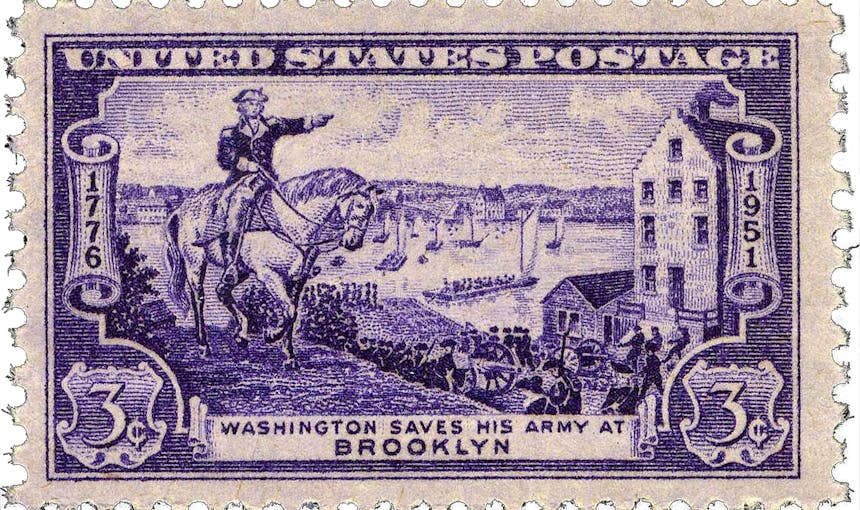
THE FIRST AND LARGEST BATTLE OF THE REVOLUTIONARY WAR, THE BATTLE OF BROOKLYN, WAS FOUGHT IN DUMBO.
In August 1776, the Patriot army fought the first and largest battle in their war for independence right here in Brooklyn. General George Washington and his troops were vastly outnumbered and it seemed that the war would be over as soon as it began. Yet Washington managed to escape crushing defeat by retreating across the East River at Fulton Ferry Landing overnight, saving his men and supplies.
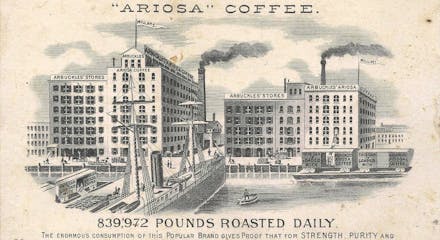
DUMBO HAD ITS OWN RAILROAD TO TRANSPORT GOODS AROUND ITS MANUFACTURING FACILITIES
Coffee business owner Charles Arbuckle established the Jay Street Connecting Railroad to transport the raw coffee beans that arrived at the DUMBO waterfront to his Ariosa coffee factories, and then back to Empire Stores, where they were stored until shipped on to further destinations. The tracks also ran inside buildings, such as the Bliss foundry at 202-206 Plymouth Street. You can see the remains of these tracks criss crossing the cobblestones to this day.
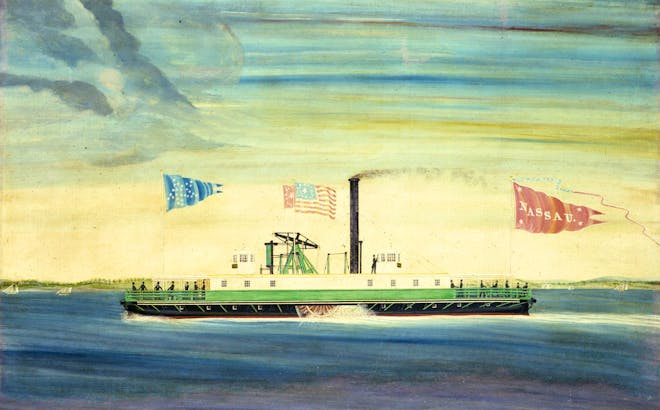
THE FULTON FERRY HAS BEEN OPERATIONAL SINCE 1642, USED BY DUMBO RESIDENTS FROM NATIVE AMERICAN FISHERMEN TO TODAY’S COMMUTERS
New York’s first ferry service began in 1642, under the management of farmer Cornelius Dircksen, and was used by both Native American and Dutch colonial residents. The Fulton Ferry officially launched in 1813, with the inaugural Nassau ferry. The service played a large role in the development of Brooklyn’s residential communities, and was beautifully immortalized in the poem “Crossing Brooklyn Ferry,” by one of Brooklyn’s most famous residents, Walt Whitman. Today’s ferry has expanded greatly, serving the length of the East River from the Rockaways to the Bronx.

WATER STREET USED TO BE THE WATER LINE
New York City has a long history of landfilling to create more livable space, and Dumbo is no exception. For most of its history, Dumbo was a salt marsh, with the water line reaching present-day Water Street. In 1686, the New York City municipal government sold the first lots of underwater land, or “water lots,” to private citizens who then filled in these spaces to build wharves and other coastal infrastructure. The waterfront build-out began in earnest in the late 18th century, pushing the shoreline farther out into the East River.
The block now occupied by the Empire Stores was part of this landfilling trend. Bounded by Main, Water, Dock, and Plymouth Streets, the site’s physical footprint was created in three landfilling episodes, from about 1796 to 1850.

VINEGAR HILL IS NAMED AFTER A BATTLE IN THE IRISH REVOLUTION
Vinegar Hill is named after the Battle of Vinegar Hill from the Irish Revolution in 1798. Landowner John Jackson thought of the name in an attempt to attract new Irish immigrants to settle into the area.
BUILDING BY BUILDING
What's the story of your address?
CREDIT: ARCGIS BASEMAP
BLACK HISTORY OF DUMBO
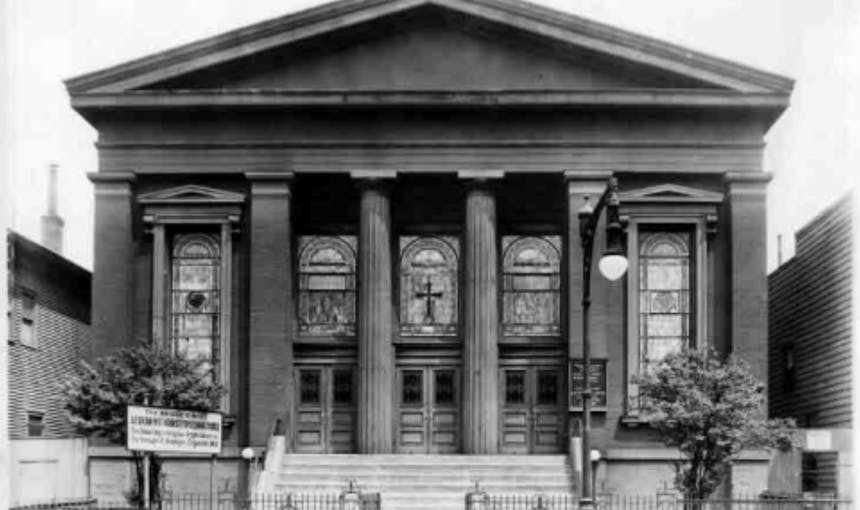
THE FIRST BLACK SCHOOL IN BROOKLYN WAS OPENED IN DUMBO
In 1812, a local church sponsored the creation of the first school for Black children in the area. Church schools were the only source of formal education for Black children in early 1800s Brooklyn, as public schools restricted the enrollment of Black students. The Concord Baptist Church, Siloam Presbyterian Church, and the Bridge Street African Wesleyan Methodist Episcopal Church all originated in the Dumbo area before later moving to Bedford-Stuyvesant. Many of these churches were also important sites along the Underground Railroad.
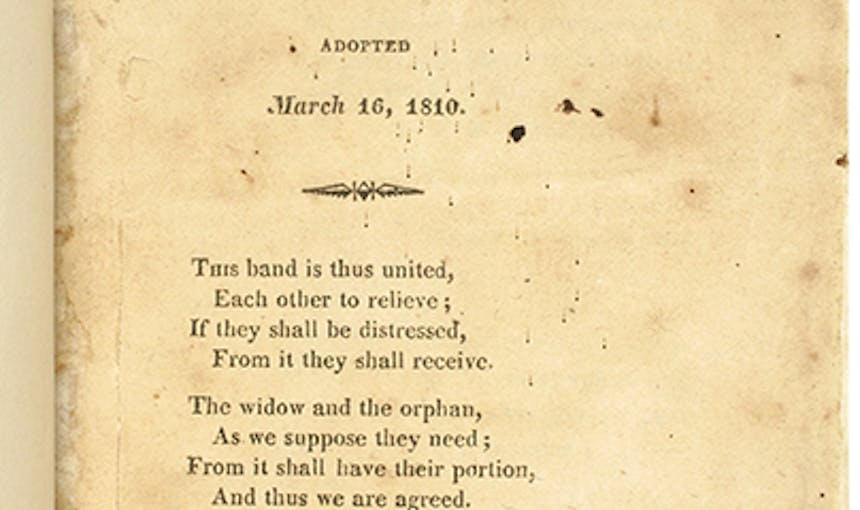
DUMBO WAS THE HOME OF THE BROOKLYN AFRICAN WOOLMAN BENEVOLENT SOCIETY
The small free Black mutual aid organization provided financial assistance to community members in need and was at the center of anti-slavery activism in Brooklyn. Founded in 1810, the African Woolman Benevolent Society coordinated freedom marches and parades across Brooklyn and collaborated with anti-slavery activist groups in Manhattan and across the country. The abolition of slavery in New York came 17 years after the society’s founding, in 1827.

BY THE LATE 19TH CENTURY, DUMBO WAS THE SITE OF NUMEROUS BLACK-OWNED BUSINESSES
Black residents of Dumbo opened cobbler’s shops, stables, and whitewashing businesses. The neighborhood was one of the first major free Black communities in New York.
BETWEEN THE BRIDGES


THE BROOKLYN BRIDGE
Completed in 1883, the Brooklyn Bridge was the world’s first steel-wire suspension bridge. Now an iconic feature of the New York skyline, the bridge was initially created to connect the two (then separate) cities of New York and Brooklyn. The bridge was designed by German engineer John Augustus Roebling; who is credited in a major advancement in the design of suspension bridges. In adding a web truss to both sides of the infrastructure, the bridge would have no fear of collapsing due to high winds or storms. After that in 1867, his design for what is now known as the Brooklyn Bridge was approved. Although John Augustus Roebling was the original engineer, shortly before construction began Roebling died, leaving his son Washington as Chief Engineer. (He was the natural choice, having worked with his father on the design of the bridge.) Construction was tough, and dozens of workers perished in the process, either from Caissons disease (known as “the bends”) or from fatal falls. Washington himself developed Caissons disease, and was paralyzed during construction. His wife, Emily Warren Roebling, stepped in–though Washington retained the official title of Chef Engineer, it was Emily managed the day-to-day details of the process, seeing the bridge to completion. At the time it would be the very first steel suspension bridge, boasting the longest span in the world: 1,600 feet from tower to tower. Emily was the first person to cross the bridge upon its unveiling–carrying a rooster with her for good luck! A cultural attraction to this day, the Brooklyn Bridge carries more than 100,000 vehicles and pedestrians daily.

THE MANHATTAN BRIDGE
Younger than the Brooklyn Bridge, construction for the Manhattan Bridge began in 1901. While initially intended for trains, the bridge opened to all traffic in 1909. The Manhattan Bridge was designed by engineer Leon Moisseiff; he based his design on deflection theory, saving on material costs and construction time. The last of the three suspension bridges to cross the East River, it was almost named the Wallabout Bridge, refereing to th Wallabout Bay, on the Brooklyn side. (A 1905 OpEd in the New York Times ridiculed the name choice, saying “All bridges across the East River are Manhattan bridges.”) The Manhattan Bridge has undergone frequent repair and upgrades since its first opening (most alarmingly, perhaps, was a 1956 repair intended to fix a tilt caused by subway use! The most recent renovation, in 2007, has since allowed for some150,000 cars to travel daily across the bridge. The Manhattan Bridge is one of New York’s most iconic images, and you can get the best shot from Dumbo’s Washington Street!
INVENTED IN DUMBO!
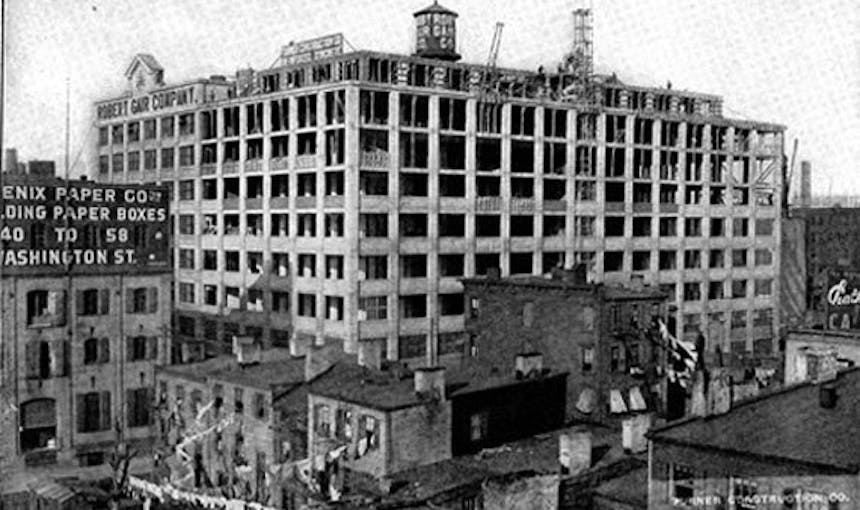
THE CARDBOARD BOX
Perhaps Dumbo’s biggest claim to fame, the cardboard box was invented by none other than Dumbo developer Robert Gair. Originally from Scotland, Gair moved to Manhattan and entered the paper-goods industry, creating paper bags in Tribeca. As with so many good inventions, the leap from paper bag to cardboard box was a mistake. A worker error in 1879caused the tearing of 20,000 paperboard seed bags, and sparked an idea in Gair: he realized that by perforating and creasing paperboard, he could create prefabricated boxes. Until now, boxes were made by hand, and were expensive. Gair moved his operations to Dumbo (he was buddies with the Arbuckles), and bought and built so many buildings the neighborhood was called Gairville for years. He patented a box-folding machine, and got into the printing business. In 1896, Gair produced 2 million printed boxed for Nabisco’s new-fangled boxed biscuits, Uneeda, and cardboard box went, well, viral. Today, the Gairville Buildings are owned by Two Trees – and you can still see Gair’s mark on each entrance.

COFFEE (THE ROASTED, PACKAGED KIND)
Jon and Charles Arbuckle were the first in the U.S. to sell processed coffee beans, packaged for individual sale instead of bulk orders. Philadelphians by birth, they settled in Dumbo in 1871, significantly expanding their Ariosa coffee empire (“Ariosa” = A for Arbuckle – Rio, as in Brazil – SA, as in South America.) At the time, the Brooklyn waterfront was already on the coffee map–85% of imported coffee came through its ports, but what really put it on the map was the process the Arbuckles invented, which they later patented, for roasting and coating coffee beans with an egg and sugar glaze to seal in the flavor and aroma. By 1906, about 25 million pounds of coffee were roasted at their main location, at 25 Jay Street, each month. At their peak, in the 19-teens, the Arbuckle empire spanned many Dumbo blocks and was entirely self-contained: they owned the warehouses where product was stored, they controlled the modes of transport, they refined the sugar (see below), they printed their own packaging – they even had a hospital for their employees! The Arbuckles continued thier Dumbo operations until the late 1930s. Today, 25 Jay is home to another Dumbo-born coffee empire, The Brooklyn Roasting Factory.
Brownstoner has a great three-part series on the Arbuckles. It’s definitely worth a read!
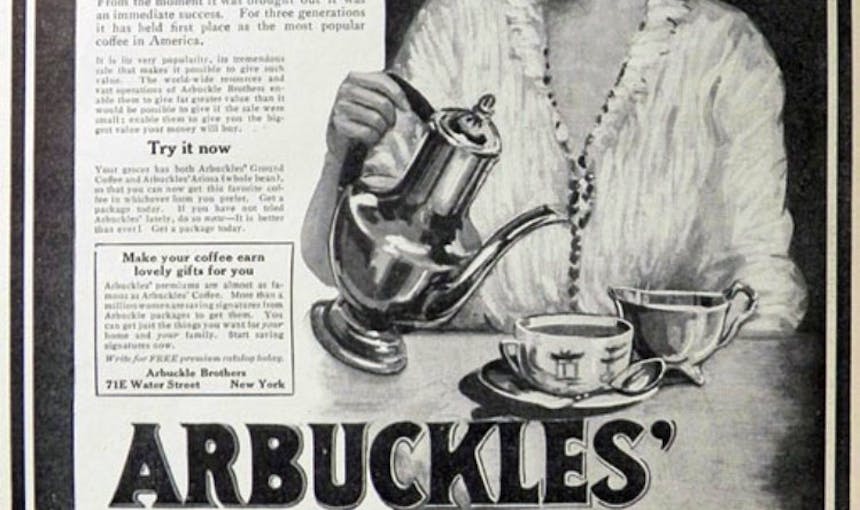
SUGAR
The Domino Sugar factory in Williamsburg–the Havemeyer Sugar Company’s main refinery–looms large on the East River. But it’s not the only sugar refinery to have graced the Brooklyn Waterfront. The Arbuckles relied on sugar for in innovative coffee process, and needed a lot of it. When the Havermeyers wouldn’t give them a discount, they decided to set up their own refinery at 10 Jay Street! At its peak in 1913, their factory produced some 5,000 barrels of sugar a day! (You can still see some of the steel “feet” of the building in the John St section of Brooklyn Bridge Park.) Havemeyer retaliated by getting into the coffee business. He acquired the Woolson Spice Company of Toledo, Ohio, and went on to package and distribute “Lion” coffee. It was the beginning of the Sugar and Coffee War – a “war” cost both sides astronomical amounts of money, and which lasted for years, until Havemeyer folded. The Arbuckles went on refining sugar until 1945, when it was converted into a warehouse.

THE FIRST GROCERY CHAIN
The Grand Union Company, one of the largest grocers of the 20th century, got its start in Dumbo! Cyrus, Frank and Charles Jones moved their company (née the Jones Brothers Tea Company) to the neighborhood in the late 1800s, making their mark selling coffee, tea, spices, baking powder, & flavoring extracts. By the time they moved in to their Dumbo headquarters – at present day 68 Jay St, in 1897 – they were well on their way to becoming one of the largest grocery chains in the United States. At 68 Jay, the Grand Union warehouse had 10 acres of floor space, and at its peak, shipped 120,000 cakes of soap and 20,000 pounds of baking soda each day. The company’s yearly output of coffee was 32 million pounds. Read more over on Brownstoner.
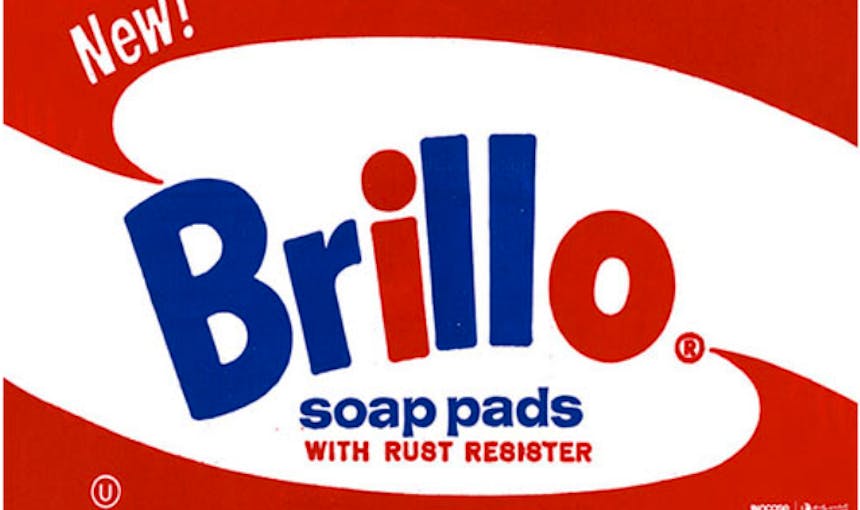
BRILLO PADS
The Brillo pad, a now ubiquitous tool in kitchens across America, was first manufactured in 1917 out of the factory at 200 Water St! A cookware peddler and a jeweler found a way to remedy the blackening of aluminum pots and pans with just jeweler’s rouge, soap, and fine steel wool—and it took off overnight. The Dumbo factory was in production until 1955.
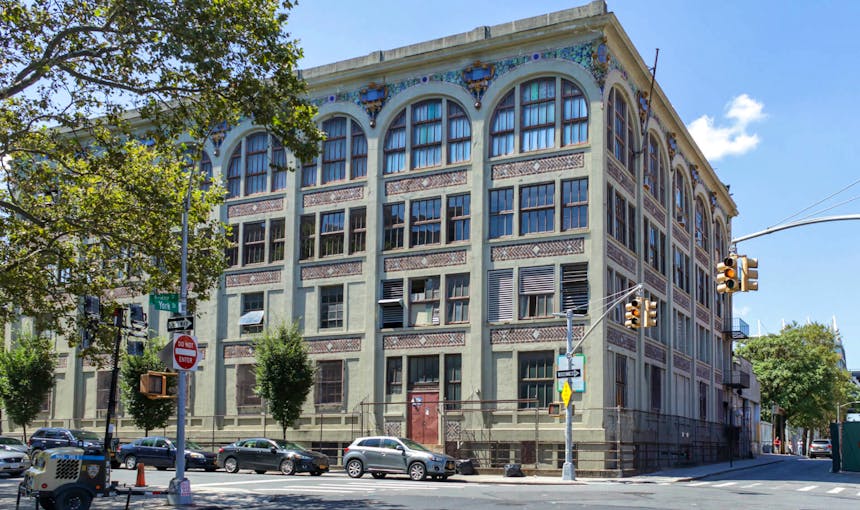
WATER METERS & ESKIMO PIE
Though not technically invented in Dumbo, the NYC water meter owes its story to the gorgeous, candy-colored building on the corner of York and Bridge Streets. In 1899, the city of New York ordered every public building install a water meter – and Scottish-born John Thomson saw his opening. Thomson, who invented one of the only city-approved water meters in 1887 (he would go on to hold 350 patents during his lifetime!) moved his production to Washington St, in Dumbo. Demand was so high, that in 1908 he purchased the lot at 100-110 Bridge Street and commissioned New York architect-engineer Louis Jallade to design and build his new factory. The resulting building was lovely, with six different colored glazes and all kinds of fanciful touches (lion’s heads, cartouches, leaves and other motifs.) Thomson died in 1926. His company was sold, and relocated to Queens, and a year later, the 100-110 Bridge was purchased by the Eskimo Pie Corporation, who proceeded to churn out their foil-wrapped, chocolate-covered ice cream bars in Dumbo until 1966!

WEST ELM
A fun fact about one of our favorite homegrown home goods stores: West Elm was born and raised in Dumbo! West Elm was founded in the neighborhood in 2002, and they opened their first-ever store right here in December 2003. Today, West Elm’s flagship space anchors the beautiful Empire Stores, with their headquarters right upstairs.
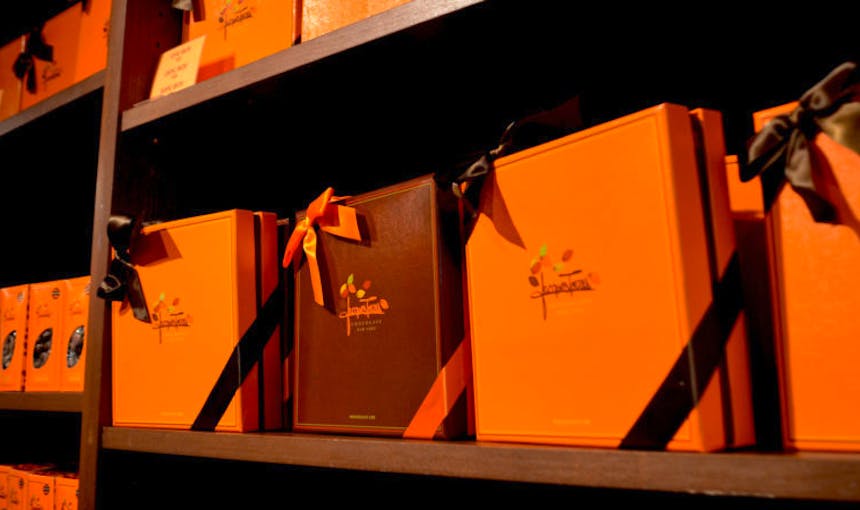
JACQUES TORRES CHOCOLATE
Jacques Torres is Dumbo’s most famous chocolatier. This chocolate-cum-reality-TV-star got his start at 66 Water in 2000, the site of his original commissary, and first ever retail space.

TIN CANS, TOOLS, PAPER & TORPEDOS
After settling in Dumbo after the Civil War, machinist E. W. Bliss opened his first shop in 1867. He continued to acquire property in the neighborhood until he owned the entire block bounded by Plymouth, Adams, John, and Pearl Streets. He built what is today 135 Plymouth (which is really a complex of three different buildings!), which became the headquarters of machine business. With over 186,500 square feet of interior manufacturing space, the list of items the Bliss company manufactured was long, and included all sorts of sheet metal products, tools, tin cans and packages, car parts and even, for a while, torpedos. In fact, the building complex included a “factory within a factory” – accessible via gangways – and designed to contain any accidental explosions! Bliss died in 1903, and his company carried on for another three decades. The building went on to house the The Waring Envelope Company, a paper recycling Today, 135 Plymouth is a mixed use space, and soon to be home to the 60th branch of the Brooklyn Public Library.





